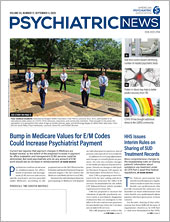Now well into the pandemic lifestyle, the novelty has worn thin. The trips I had planned for 2020 are all canceled, a long-weekend family reunion has been replaced by a 90-minute Zoom call, and annual traditions with friends are scrapped. The most difficult part for me is not knowing when I will see certain people again. I realize I am lucky: I live with a partner I love and the best dog in the universe. The pandemic is creating unprecedented disruption in social connectedness for all of us, but especially for those who live alone. I am particularly concerned about seniors and adolescents.
Earlier in the pandemic, 13.6% of U.S. adults reported symptoms of serious psychological distress, which is three times higher than two years before (3.9%), according to a survey reported in the June 3 JAMA. Among respondents aged 18 to 26, 34% reported distress this past April, compared with only 3.7% in April 2018, a ninefold increase. Paradoxically, loneliness tripled among those who live with others and “only” doubled among those who live alone. This highlights the importance of National Institute on Aging research demonstrating that social isolation and loneliness, although connected, are not equivalent.
A Harris Poll commissioned by 4-H in May asked 1,500 youth about their mental health. Among the results: 61% said that the pandemic has increased their feelings of loneliness, 55% reported anxiety, 43% reported depression, and 64% believed the pandemic will have a lasting impact on their generation’s mental health. The teens also reported that they spend 75% of their waking hours on screens. As psychiatrists, we all know that excessive screen time is associated with adverse outcomes for children and adolescents, particularly with regard to diet, weight, depressive symptoms, and quality of life.
Solutions for adolescents may be relatively easy to negotiate, to the extent that one is able to negotiate with a given adolescent. The Colorado Psychiatric Society has gathered an impressive collection of activities for families and children to help engage youth in non-screen activities. Please encourage your patients to check out the links on our
Resources for the Public webpage. The APA website also contains useful information at
psychiatry.org/covid; scroll down to “Resources for Families.” Many parents of adolescents have decided to bend the rules for their kids, allowing them to venture out with their friends because of a recognition that social groups and friendships are like air and water for teens.
Among the resources missing from many children’s lives during the pandemic are their grandparents. There are countless heart-wrenching news stories about family members trying to connect with elders quarantined in nursing homes. Although the need for quarantine is understandable if the goal is isolation of the virus, the rigidity of the quarantine suggests that policymakers have lost sight of the larger picture of health for people living in nursing facilities. To lock an elderly person in a room with almost no human interaction is to invite cognitive, emotional, and physical decline. Think about what we know about solitary confinement. Even elders who live independently are exhorted to maintain strict shelter-in-place protocols as the rest of society opens up a bit. Long before the pandemic, we knew that social isolation can induce depression, reduce immune function, increase oxidative stress, and is associated with dementia in seniors.
Humans evolved as social animals. We need interpersonal connection for our very survival. Loneliness is harmful, and loneliness during a period of increased stress because of a deadly virus and social upheaval may be especially burdensome. The paper “Neurobiology of Social Distance” is the best I have found and worth the time to read.
Have we created a false binary: seniors must be completely isolated or else they risk dying from the virus? Could we imagine responsible ways to soften the degree of isolation without sacrificing safety? How might psychiatrists join the public health conversation about the way we’re treating our seniors? A call for research on combating loneliness published in JAMA contains excellent ideas, including for individual and societal interventions. The United Kingdom has created a Campaign to End Loneliness; the website includes some charming short videos about talking to strangers, making friends, and other forms of connection.
Perhaps the pandemic will be a catalyst for reprioritizing where we place our elders in the social fabric, recognizing the importance of the multigenerational family, and rethinking public policy to be more relationship centered. ■
“Psychological Distress and Loneliness Reported by US Adults in 2018 and April 2020” is posted
here.
“The Neurobiology of Social Distance” is posted
here.
“Battling the Modern Behavioral Epidemic of Loneliness: Suggestions for Research and Interventions” is posted
here.
Information on the Camaign to End Loneliness is posted
here.

